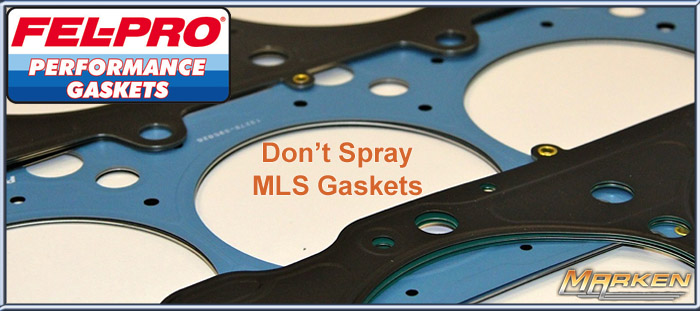For Your Fel-Pro Gaskets in Canada & USA, call Marken Performance @ 1-888-401-1362

Multi-layer steel head gaskets have become all the rage lately, especially in high-stress racing engines, and Fel-Pro has a complete lineup of product in its catalog. There is an MLS gasket for just about every application. In fact, Fel-Pro’s Ron Rotunno says, “”We have more than two dozen models alone for the LS line of engines.”
However, one item that constantly comes up in discussion during the installation of said gaskets is whether they should be sprayed with sealant upon installation. In fact, Rotunno says it’s probably the most-asked question of the show from his perspective.
And the answer? Quite simply, no. “We do not recommend spraying Fel-Pro multi-layer steel gaskets with copper sealant or any other substance. They should be installed dry right out of the package,” he says. “We can’t say for sure that sprays won’t react in some way with the rubber coatings. You could get also overspray on top, which could lead to leakage, or you could get spray between the layers, which will also cause sealing issues. Finally, when it’s time to take the engine apart, it’s a much cleaner job without any type of spray.”
The four-layer gaskets (three active layers, one shim layer) perform like a spring to maintain consistent contact pressure between the engine block and cylinder head. The gaskets are embossed to prevent fluid leakage around critical areas.
There are two different types of rubber coatings used on the MLS gaskets from Fel-Pro. OEM and OEM-replacement applications use a softer blue coating that’s designed to seal surface finishes that are a bit rougher, and provides more leeway when engine machining is not superior as it would likely be in a racing application.
The black coating is a bit harder and doesn’t conform to those surface imperfections as easily as the blue gaskets do, but they aren’t designed to do so, as most racing engine builders have the capability to provide fine surface finishes that are able to make use of the black gaskets’ sealing properties.
In addition, the black coating is much more durable and will withstand much higher chamber temperatures.
When constructing a performance engine, it can often be a challenge to track down all of the necessary gaskets to ensure a complete seal, as often there can be running engineering revisions in engine components throughout the years. Thankfully, the folks over at Fel-Pro have made the job simple with dedicated Performance Full Sets of engine gaskets. These kits offer the end-user the opportunity to find the exact parts that are required to seal up a complete engine. “Essentially, everything we have in the Fel-Pro product line that’s the upper-echelon part goes into this kit,” says Fel-Pro’s Ron Rotunno. “Head gaskets, rubber/steel one-piece oil pan gasket, front and rear crank seals, and more. The whole idea is that if you never want to see any leaks, this is the turnkey solution, and the best of everything we have to offer.”
For example: 428 ci small block Ford Windsor: the Fel-Pro catalog quickly provided the correct part number — 2816 — for the intended application. The kit comes with a pair of multi-layer steel (MLS) head gaskets, performance intake manifold gaskets, exhaust manifold gaskets, and oil pan gasket, water pump gasket, and every other item needed to take an engine from a pile of parts to a completely-sealed, ready-to-run powerplant. Although this project is based on a Ford, Fel-Pro gasket kits are available for numerous applications for a variety of marques in the performance-engine market. “Head gaskets need to seal the combustion, seal high pressure oil, oil pressure drainback, and coolant. With higher-horsepower engines, you get a lot of cylinder head lift, and when the cylinder is under power it wants to pull the head right off the deck. These are 4-layer hard stainless-steel material gaskets that have embossments in them, and the embossments are what actually seal the application. When the head tries to lift, the gaskets will follow the motion of the head and maintain the surface pressure and contact pressure in those areas to seal the combustion,” says Rotunno.
“The valve cover gaskets and the one-piece oil-pan gasket are both constructed of silicone rubber with a steel insert that also has compression limiters built in so you can’t over-tighten them. The design offers a nice combination of heat resistance, fluid resistance, and compression set,” Rotunno explains. “You can adjust the rocker arms and just wipe off the gasket and re-use it. There are also multiple sealing beads. The idea there is that if the flange surface on the valve cover or oil pan isn’t perfect, the gasket will still catch the oil. It’s a way to make them foolproof for our customers.”
News
- Mar 26 2019 EBC New RP-1 Brake Pads for Racing
- Mar 11 2019 Bushwacker DRT Style™ Fender Flares
- Feb 23 2019 Flowmaster Cat-Back 717889 fits 2019 RAM 1500 Hemi
- Feb 11 2019 Optima Yellowtop Rectangle Battery # 9048-148, H6 Group 48
- Jan 18 2019 Holley New Larger EFI Pro Dash
- Jan 08 2019 Lucas Oil Low Viscosity Stabilizer #11097 + #11096 Intake Cleaner for Gasoline Direct Injection Engines
- May 05 2018 Thermo-Tech Rogue Series T3, T4 Turbo Cover
- Apr 30 2018 Holley’s Mid-Mount Kit # 20-200 for LT Swap, with accessories
- Apr 27 2018 SCT BDX Performance Programmer + Monitor + Adjustments
- Apr 23 2018 ReadyLift 7 inch Lift for 2014_UP Chevy 1500
Industry News
Loading
- Marken Performance
- About Marken
- All Brands
- Services
- News
- Gallery
- Contact
- Sitemap
- Customer Service
- FAQ's
- Parts Request
- Customer Survey
- Terms of Use
News
- Mar 26 2019 EBC New RP-1 Brake Pads for Racing It was the first outing for EBC Brakes Racing’s new RP-1 pads via Marken Performance... »»
- Mar 11 2019 Bushwacker DRT Style™ Fender Flares This new Fender Flare design, available soon via Marken Performance, has a vented design for... »»
Directions
123 Ottawa Street SouthKitchener, Sele
N2G 3S8
F: 1-519-893-5857
WSM SSL
- Visa
- Mastercard
- Paypal
Copyright © 2026 Marken Performance . All Rights Reserved.
Powered by Web Shop Manager.
Powered by Web Shop Manager.


You must login to post comments.